

8th Generation Honda Civic Launch for Malaysia
|
With this eight generation Civic, we are reinventing new values that surpass all
existing cars in this class.
Yasuhide Mizuno, MD & CEO, Honda Malaysia
|
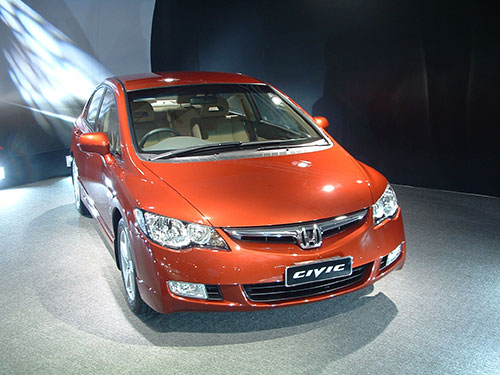 After months of waiting, Honda has finally launched the 'new' 8th generation Civic
here in Malaysia. With this launch too I finally had my chance to check the new Civic up
close. Technically the launch held no real surprises for me. Most or all of the
specifications and features are already well known and really it was more a question
of confirming that there would be no specification downgrades as well as confirming which
feature have made it to the Malaysian units and which have been left out.
After months of waiting, Honda has finally launched the 'new' 8th generation Civic
here in Malaysia. With this launch too I finally had my chance to check the new Civic up
close. Technically the launch held no real surprises for me. Most or all of the
specifications and features are already well known and really it was more a question
of confirming that there would be no specification downgrades as well as confirming which
feature have made it to the Malaysian units and which have been left out.
On the other hand, because this was the first time I will be taking a look at the actual car there were two other, should I say, more important issues to tackle. First is for me to take a look at the car and then size up my own reaction to this. For this, I had in mind the rather polarized opinions I have been receiving from TOVA readers who have seen the car before me, either at the Tokyo Motor Show, or at the countries where it has been launched early (specifically Thailand, Singapore and Australia). So I wanted to see for myself the real car, in order to understand some of the comments that I have received about the car and hopefully put it into some sort of perspective for other TOVA readers who have yet to see it in real life. Secondly, and more importantly, after hearing so long all those 'urgency' messages from Honda, about how eager they are to get the Civic back on track and how serious they want it to be accepted again by Civic fans, I am eager to understand the concepts and objectives Honda had when they designed this new Civic.
The Cars
|
The target group for our 2.0S, our flagship model, will consist of both
young working professionals and entrepreneurs while the 1.8S which is the volume
seller, will be targeted to professionals with family
Yasuhide Mizuno, MD & CEO, Honda Malaysia
|
First, I want to take a quick overview of the new Civic, in terms of their packaging. The information here will probably be available from most of the regular auto publications but this overview is written from the unique viewpoint of TOVA readers.
As expected, Honda Malaysia launched two variants of the Civic sedan here in Malaysia, in line with what had been launched in Thailand early this year. So Honda launched both the 1.8l and the 2.0l Civic sedan. Of particular interest is the fact that Honda Malaysia is using a different model naming standard for the Civic as compared to Thailand. In the HAT website, the 1.8l is named Civic 1.8 i-VTEC and comes in Types S and E, while the 2.0l is Civic 2.0 i-VTEC and comes in types E and EL. For Malaysia, Honda had the Civics named 1.8S and 2.0S and these names are what is used in the press release and official literature. This naming convention might be something trivial but personally it is a welcomed move as it heralds back the good old days where we call Civics by names such as 25X, 36is and of course SiRs.
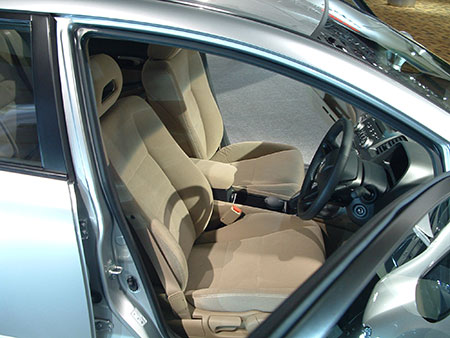 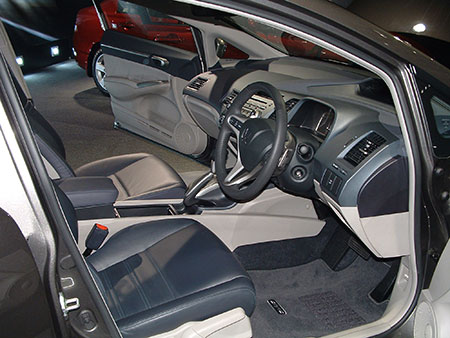 |
As with the MMC City late last year, and as I predicted early this year, the 1.8l and 2.0l are clearly differentiated as they are packaged to appeal to different market segments. As would be logically expected, this differentiation is based on the two engine variants. In this case, the 1.8l is clearly packaged at the more general buyer while the 2.0l which comes at a price premium is of course aimed at the more 'discerning' buyer. I would have liked to say Honda packaged the 2.0l expressively at the enthusiasts, like how they have done with the Jazz VTEC and City VTEC but while this can be said to be true to a large extent, ultimately the 2.0l Civic has been compromised for the requirements of the general market. As seen in the quote above, Honda Malaysia's CEO Mr Yasuhide Mizuno explained the two variants' target groups; the 1.8l being the expected volume seller was targetted at professionals with family (and hence a bias towards comfort) while the 2.0l was meant to be the flagship of the local Civic line-up and is being targetted at young working professionals and entrepreneurs. Thus, no direct mentions about enthusiasts for either variant of the Civic.
As I predicted, the 1.8S comes with a two-tone biege based cloth interior while the 2.0S comes with a two-tone black leather based interior. Both 1.8S and 2.0S comes fully equipped with almost every conceiveable feature under the sun ! I am especially glad that the 1.8S eventhough packaged as the 'mass market model', has also been equipped with the superior 5speed GLC gearbox and 16" wheels. The safety features are almost identical with the 2.0S and so the 1.8S too gets the full complement of SRS, ABS, EBD, BA, 'active headrests' and VSA (which includes traction control), the only significant ommission being the side airbags. The item 'active headrests' bears additional clarification. The front seat headrests in both 1.8S and 2.0S are not absolutely fixed in position. In the cases of frontal collision, the driver and front passenger's head will be thrown back violently. Via a mechanism in the front seats, when this happens, the headrests are mechanically moved forward and downwards. This will help cushion the driver and front passenger, especially their necks, against the violent backlash and helps to prevent whiplash and other head and neck related injuries in the unfortunate occurrence of frontal collisions. It also applies when the car is being rammed in the rear. I think this is a rather important additional safety feature in the new Civic that bears mention.
The 2.0S of course also has side-airbags, HID and sequential shifter as extras. These are essentially 'enthusiast items', meaning that only enthusiasts will go 'ga-ga' over such things while the normal buyers might even balk at the extra costs they incur. This is why I mentioned that eventhough the enthusiast is not specifically mentioned as a target market for the 2.0S, it do have numerous features that are obviously targetted at us. Incidentally, it is important to highlight that the side-airbags on the 2.0S has an 'Occupant Position Detection System' meaning that there are sensors to detect the presence of the front passenger. The rest of the extras on the 2.0S are the so called 'great-to-haves' like steering wheel mounted controls, cruise control, side mirror mounted turn indicators, and 'hydrophilic' side mirrors (i.e. mirrors with a surface quality much as if Rain-X has been applied to it, causing rain water to simply slide off). The sound system in the 1.8S is a single CD MP3/WMA system while the 2.0S has an in-dash 6-CD changer with MP3/WMA system. Both 1.8S and 2.0S now has 6-speakers and both also has a line-level aux-in jack which adds an external source capability like iPod to the audio system. The antennas for radio reception on both variants are the glass-printed types, thus doing away with a separate antenna sticking out of the car like a sore thumb. Individually these features might not make much of an impact on the prospective buyer, but together they can the new Civic look very attractive indeed.
An important feature that have been lefted out (compared to the Thailand version) but which few are aware is the headlight auto-levelling function. This is a feature that allows the tilt of the headlights to be automatically adjusted to the number of passengers in the car. For e.g. the longitudinal tilt of the car (front or rear dip) depends to some extent on the number of passengers in the car, especially the rear passenger. Having a full complement of 5 people in the car compared to just the driver and front passenger for e.g. will cause the car to be tilted forward to a different degree. This then changes the alignment of the headlights. The change is actually quite unperceptible. In addition, it is most important to highlight this feature is not available in any compact car that I know of and indeed very few full-sized car has it as well. Even those super expensive luxury 'continental' cars like Audi's and BMW's used to have manually adjustable tilt with the very latest (and super expensive) models only coming with automatic adjustment. So in all fairness, harping on the omission of this feature from the Malaysian units would really be nit-picking. Only thing is this is TOVA and to us enthusiasts, who are known to spend a couple of thousands (Malaysian ringgit) to retrofit aftermarket HID to our cars, this needs to be mentioned in the interest of completeness. Also, better that I highlight it and then put it into the proper perspective rather than have some detractors raise it up and having a field day spreading misconceptions about the omission !
The Design Concepts
|
The key words for the new Civic are 'Look, Touch, Fun To Drive and Excitement'.
Shinichi Takahashi, Chief Engineer and LPL for 8G Civic, Tochigi R&D.
|
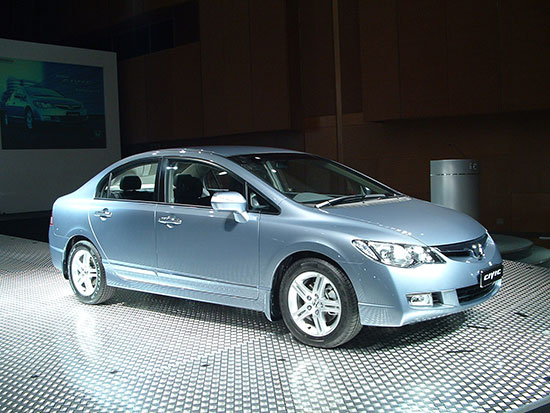 For TOVA, the most important question about this new 8th Gen Civic would
be how does it appeal to the Honda enthusiast ?. This was the core
question answered by Shinichi Takahashi, who is in charge of the Civic's development
(Honda's so called LPL or Large Project Leader and Chief Engineer for this Civic).
For TOVA, the most important question about this new 8th Gen Civic would
be how does it appeal to the Honda enthusiast ?. This was the core
question answered by Shinichi Takahashi, who is in charge of the Civic's development
(Honda's so called LPL or Large Project Leader and Chief Engineer for this Civic).
In his speech at the launch ceremony, Takahashi mentioned how during the development process for this Civic, he and his team of R&D engineers have actually been to Malaysia on May 2003 to conduct a 'user visit'. He highlighted that the result of that visit showed them that Malaysian customers have very high expectations of the Civic and many of those expectations they have incorporated into the car during its development. It was from that visit, and other corresponding visits throughout Asia where they came up with the specification for a car that has features designed for the Asian market. This was explained to be the reason why the Asian Civic is different from the USDM Civic as the USDM Civic is of course designed for the U.S./Canada market.
According to Takahashi, his own personal opinions of the outgoing 7th Gen Civic
are that it's a very good car: both compact and practical, and with the 2.0 i-VTEC,
possesses fairly good performance as well. However, he admits to feeling that it
lacks a certain allure. This 'allure', from what I gather is used to mean
the appeal to the driver. Therefore, Takahashi-san added
'we broke the shell of the current (7th Gen) Civic, retained its finer points
such as good drivablity, performance, spaciousness, safety, environmental-friendliness,
and fuel efficiency, and then we added 'elegance' and 'grace' to the car.'
So the new 8th Gen Civic promotes the idea that driving is not meant to a
'chore' but is supposed to be an attractive proposition, that this new Civic should entice
the owner to hop into the driver's seat, rather than dread the long boring drive ahead.
Key technical points from Takahashi's speech includes the fact that they have intentionally 'strengthened' (reduced) the wheel arch to tyre gap to give the Civic a sporty look, clearly a concious effort to appeal to the many owners who have lowered their cars for that low-down aggressive look. The significant difference here is that lowering a car using aftermarket springs to acheive the 'low-down' look given by small fender to tyre gaps also introduces sacrifices as well. These includes ride harshness, road clearance (and the accompanying undercarriage scrapes) and also extra strain on the suspension components like shocks, drive shafts (which must now work at an angle which is no longer the one they were designed to work with) and so forth. Of course we also get the nice improvements in handling but honestly the one key question most often asked by an enthusiast about an aftermarket spring is 'does the car scrapes it undercarriage ?'. A car that is originally designed with a small fender to tyre gap immediately gives us that desired sporty 'low-down' look but yet still offers the original road clearance and all the other important ride considerations. It is a most superior replacement to lowering springs, of course assuming that the handling of the car in stock form is up to a proper standard.
The other important design concept is the new interior that features the new, advanced Multiplex meter that have gotten lots of rave reviews. More on the interior later.
The Engines
|
To enhance drivability, the new Civic features with a newly developed 1.8l
engine combined with 5-speed Automatic Transmission that leads to good response
in acceleration and linear direct handling. The new Civic also comes with a 2.0l
engine that follows the concept of the 1.8l but it is enhanced further...
Shinichi Takahashi, Chief Engineer and LPL for 8G Civic, Tochigi R&D.
|
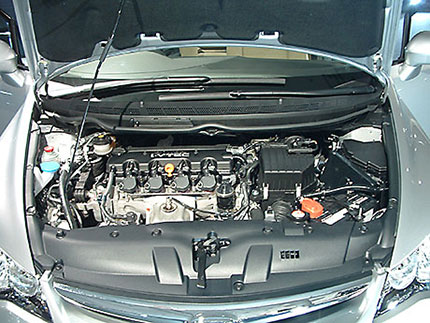 |
 |
Visually the R18A is surprisingly mounted the same way like the out-going D17A it is replacing, i.e. with exhaust facing the front, unlike the Kseries. A highly distinctive feature is the integrated exhaust manifold, which is casted as part of the single piece cylinder head. The rather large catatytic converter is bolted directly to this integrated manifold. This R18A is Drive By Wire but rather surprisingly still uses a hydraulic driven power steering system. This review of the launch is not really the best place to go into detailed technical discussion of the engine so I stop at this but I plan to publish a more technical discussion as a separate article in the near future. But first, I have a few clarifications I want to ask of the engineers for the engine and I can only do that in next week's test-drive event.
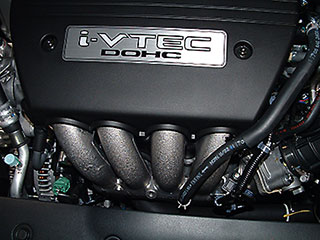
 The 2.0l too uses a new variant of the K-series and not the original K20A that is
used on the out-going ET1 Civic 2.0 i-VTEC. Coded K20Z, this engine highlights
a new intake manifold (with long runners to enhance low and mid-range torque)
and Drive-By-Wire technology. The engine probably features revised pistons
because it has a lower CR compared to the K20A (9.6 vs 9.8). Also while the max
power is identical (also 155ps at 6,500rpm), the max torque is significantly higher
(19.2 kgm vs 18.0kgm) and comes in at a lower rpm (4,500rpm vs 5,000pm) and so suggests
new camshafts and ECU programming as well. This new engine power characteristic has
probably as much to do with offering enhanced driveablity (with more power available
at lower rpms, the car feels more powerful in normal driving conditions) as with
the desire to match the engine's power delivery characteristic to the automatic
gearbox.
The 2.0l too uses a new variant of the K-series and not the original K20A that is
used on the out-going ET1 Civic 2.0 i-VTEC. Coded K20Z, this engine highlights
a new intake manifold (with long runners to enhance low and mid-range torque)
and Drive-By-Wire technology. The engine probably features revised pistons
because it has a lower CR compared to the K20A (9.6 vs 9.8). Also while the max
power is identical (also 155ps at 6,500rpm), the max torque is significantly higher
(19.2 kgm vs 18.0kgm) and comes in at a lower rpm (4,500rpm vs 5,000pm) and so suggests
new camshafts and ECU programming as well. This new engine power characteristic has
probably as much to do with offering enhanced driveablity (with more power available
at lower rpms, the car feels more powerful in normal driving conditions) as with
the desire to match the engine's power delivery characteristic to the automatic
gearbox.
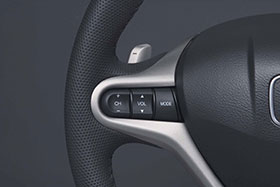
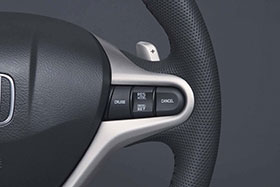
Talking about the gearbox, the main attraction of the 5AT on the 2.0S is of course the sequential shifting option, activated by steering wheel based paddles. It is a long time coming, this sequential shifting option and its arrival has of course been sweetened considerably by the paddle shifter option. The two paddles are located on the left and right of the steering wheel stalk, behind the leather steering itself. The left paddle is for down-shifting while the right for up-shifting. To activate the shift, we pull the paddle towards us. In use, the paddles have a nice solid feel and I can't wait for the test-drive event which is next week in order to get to use it in actual driving.
Exterior Design
|
The exterior employs a forward cabin, sporty monoform design, with the front window
thrust(ed) boldly ahead, emphasizing the extension of the front fenders and rear
deck with the cabin more compact lengthwise.
Official Honda Press Release for the 8th Gen Civic
|
 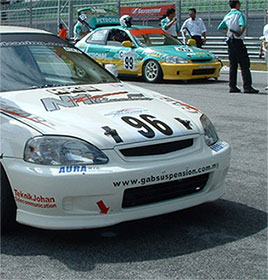  |
From my personal point of view, my reaction to seeing the new 8th Gen Civic 'in the flesh' has been gratifying in that it brings back memories of the good old days where new generations are always a bit controversial in styling, offering one or more bold elements in the exterior design. Long-time Civic fans will remember well how the best of the Civic generations would for e.g. always offer new headlights that evokes 'violent' reaction from fans. I still remember the launch of the EG-Civic here in Malaysia way back in 1992. A colleague was one of the first to get the EG sedan and when she drove it to the IBM office lobby car-park, there was a sudden mutter amongst those of us who were gathering there waiting to walk out for our lunch break. I remember my own reaction was an initial 'repulsion' to the 'slimy thin' headlights. The front reminds me of a frog while the rear boot/trunk looks stunted and insignificant. Now, decades on, the EG Civic is actually held to be one of the better looking generations by Civic fans.
Similarly when the EK Civic replaced the EG-Civic, there was an equally 'violent' reaction from Civic fans, mainly due to the huge headlights. Designed to offer up to 30% more illumination on the road, the headlights solicited rather unflattering nicknames for the EK Civic - bug-eye Civic was one and the all time favourite was a chinese phrase that literally translated to 'bulging eyes goldfish' (with the open grille bringing hints of the goldfish's open mouth !). And yet, this EK Civic is commonly held nowadays to be the all time best looking Civic generation.
Now, not wishing to hurt the feelings of their owners, the 7th Gen ES-Civic has been more of an evolution than a revolution. The exterior design was really just the EK Civic lines with the headlights shrunken in size and the bold lines softened considerably. Unfortunately similarly shrunken too was its appeal to Civic fans. The last MMC for this generation introduced a more 'shapely' headlight and some important detailed comestic changes that improved the looks considerably, but ultimately it came too late to save the generation in the eyes of the Civic fans.
Now, this new 8th Gen Civic brings back the same 'revolution' in exterior design, with relatively huge 'droopy eyes' headlights and a stunted trunk design. If anything, the hugely polarized reaction I have been receiving from TOVA readers shows just how successful Takahashi's team has been in restoring at the very least this one key characteristic of the Civic's DNA - that of a revolutionary, controversial design. On a personal basis, I liked it. A lot !

A common comment about this new Civic I have received from enthusiasts is that it is too MPV-like in overall looks. This has been a mystery to me initially because from the many photos I have seen of the car, it sure looks sporty enough for me. The crucial point was after HAT (Honda Thailand) had launched the car and from their official website for the Civic, there is 1 particular photo, which is even used as a downloadable wallpaper which illustrated the basis of the comment to me. This photo, on the left, shows a 'side 4/5th' shot of the new Civic which accentuates the longish MPV-look, Indeed the photo at that time reminded me of the Honda Stream but with a boot !
This situation reminds me very much of the original GD-City, where from 1 particular angle from near the rear of the car, it can look very ugly, even to a hard-core Honda fan like me. Thus, when the cars were presented during the launch ceremony, I made extra special efforts to check out the Civic from all angles. I am happy to say that in real-life, to my eyes at least, the new Civic look nice and sporty to me from practically all angles. Yes, I did manage to find that one angle used in the shot above where the 'MPV-look' is exaggerated. And I write exaggerated because it is only from this angle that somehow the new Civic reminds me of the Stream. I spent some time trying to analyze this. For me, the rather tall body design of this new Civic is expected. It is a given because that is the trend for today's compact cars. This is a key point to extracting ever larger interior space from the compact design, without having to enlarge the basic design by too much over the previous one, and that is by exploiting the so-called third dimension which is the vertical height. So by offering a higher roofline, the feeling of spaciousness can be enhanced.
A look at the physical proportions of the Civic gives us the clue here. The new Civic measures 70mm (~3inch) longer and 30mm (~1inch) wider than the outgoing one. More interestingly, it is actually 5mm shorter (in height) than the 7th Gen Civic (1435mm vs 1440mm). But why does it look like an MPV from the 'wrong' angle ? The clue is the wheelbase (distance between front and rear wheels) which has also been lengthened by 80mm, from 2.620mm to 2,700mm. Thus the front and rear wheels are now further apart, the difference been clearly visible and this extra distance has also been exaggerated by a longer body. The nett effect is to give an illusion of an 'elongated' car and I think helps to explain why while visually this new Civic is 'sleeker' and more sporty, from the wrong angle it can offer a nagging reminder of the Stream.

However, this 'weakness' in the exterior design seems to be, like the case of the original Honda City, really applicable from only 1 particular angle. From all other angles of viewing, especially from a frontal 3/4 view, the new Civic looks very much more sporty, at least to my eyes. The car looks much sleeker and aerodynamic, the longer length and shorter height working very well with the sloped bonnet/front mirror while the sloped rear glass works well with the 'stunted' boot to project an aerodynamically pleasing shape. In the launch itself, Honda has also prepared a Nighthawk Black unit fitted with the optional Honda Access Modulo bodykit and this unit looks especially attractive to my eyes as an enthusiast, the impression of sportiness being especially enhanced by the twin tailpipes which are standard features on both 1.8S and 2.0S. Unfortunately my often made complaints about the weak flash on my Fuji digital camera made half of the photos I took of that car unuseable so my plans to publish my third TOVA Feature Car article using that unit will have to wait until next week when I expect to see it again during the test-drive event.
Interior Design
|
...we enhanced the quality and the user-friendliness of the interior. This time
the new Civic has incorporated an advanced Multiplex meter that maintains an enhanced
level of safety while driving and monitoring (of) the instrument panel.
Shinichi Takahashi, Chief Engineer and LPL for 8G Civic, Tochigi R&D.
|
 One area which I feel Takahashi
and his team has been most successful with this new Civic is the interior. For
decades, Civics have universally been blasted as having 'functional but dull'
interiors. But this new Civic has managed to break the mold by offering an interior
that truly elicits emotional reaction from those who sees it. While the exterior
has received polarized reactions, the interior is more or less universally successful
in its appeal to all who have seen it. A perfect example is my wife, whom I took
to check out the Civic at a local Honda dealer after the launch. Her first
reaction when the salesman used the ignition key to light up the dashboard display was
literally 'WOW !'. And I have seen this same reaction repeated again and again, even
from enthusiasts. The general reaction is that the new dashboard is very futuristic.
My wife says it gives her an impression of being on the bridge of the starship
Enterprise (NC-1701) !
One area which I feel Takahashi
and his team has been most successful with this new Civic is the interior. For
decades, Civics have universally been blasted as having 'functional but dull'
interiors. But this new Civic has managed to break the mold by offering an interior
that truly elicits emotional reaction from those who sees it. While the exterior
has received polarized reactions, the interior is more or less universally successful
in its appeal to all who have seen it. A perfect example is my wife, whom I took
to check out the Civic at a local Honda dealer after the launch. Her first
reaction when the salesman used the ignition key to light up the dashboard display was
literally 'WOW !'. And I have seen this same reaction repeated again and again, even
from enthusiasts. The general reaction is that the new dashboard is very futuristic.
My wife says it gives her an impression of being on the bridge of the starship
Enterprise (NC-1701) !
An important area of focus by the engineers is the driver's space. The new Civic is envisaged to 'entice' the driver into the driver's seat. As I highlighted above, the desire is to move away from the traditional view of driving as being a 'chore'. The new Civic is not to be taken as 'just another car to get from A to B'. The idea is that the drive itself should be one of the joys of life as well. So instead of dreading the boredom of the coming long drive out of town, the idea is that the driver should actually be able to enjoy it should he or she have to make such a drive. The ideal of course would be that the driver actually looks forward to it. But I've have to apologise to my friends at Honda Malaysia here and be bluntly honest about it. To enthusiast, a large part of this would require a level of performance that frankly I do not expect even the 2.0S to be able to deliver. But I run the danger of pre-judging so I'll leave the final judgement till after the test-drive event. Perhaps the new Civic will actually make me want to drive it ?
Nevertheless, the new Civic has many design features meant to enhance the driver's experience. Gone more or less un-noticed in the launch was a mention in the short technical presentation about how the new front seats have been revised, with new cushion materials, new covering materials and indeed new physical dimensions. The key point that was made was that Honda wants the driver to sit IN the driver's seat, not ON it. By this, Honda pretty much wants to make a similar distinction to what we often do when we call a house our home and not just a house.
The interior cabin too has been designed to offer an enhance sense of quality and user-friendliness. They key here is the new 'multiplex meter' that offers multiple layers of instrumentation, putting the speedometer and turn indicators for e.g. at a level right at the top, almost on the top of the dashboard. Feedbacks from U.S. owners who were the very first fortunate people to enjoy the new Civic were universally positive, with some even likening the effect to almost like that of having a HUD (Heads Up Display, much like that of a fighter jet). The very steep slope of the front windscreen is intentional. This allows the dashboard to be moved forward and this liberates a lot of space below the dashboard, where the feet have to work the pedals. Coupled with a new design small diameter steering wheel (this is also obviously another result of seeing how many enthusiasts have changed to a small diameter 'sports steering') which has both tilt and telescopic (forward and backward) adjustments and a driver's seat which includes height adjustment, this means the new Civic is capable of being adjusted to cater for drivers of practically almost all physique. This is of course core to the principle that driving the new Civic should be a joy, not a chore.
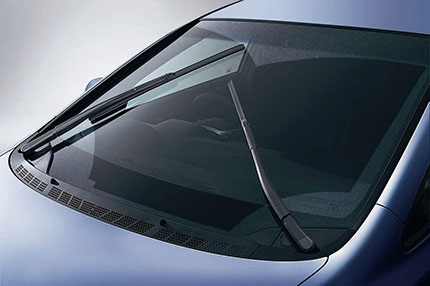
Other thoughtful features which affects the driver/passengers would be the new design wiper blades. These are mounted in a unique extreme left-extreme right hinged layout, with the two wipers of almost equal length and sweeping from an overlapped middle resting position out to both extremes of the front windscreen. This new layout has a very much superior cleaning pattern as the only part of the windscreen not cleared of rain would be a roughly triangle piece located at the top center of the windscreen, an area which is probably never used and from inside the car, is blocked by the rear-view mirror anyway ! So this new Civic will give superior visibility in the rain, due to the new wiper design. The wiper blades themselves are the new design that is being adopted in many JDM Hondas. They are the thin aerodynamic types that reduces wind-noise especially in use when cruising at high speeds.
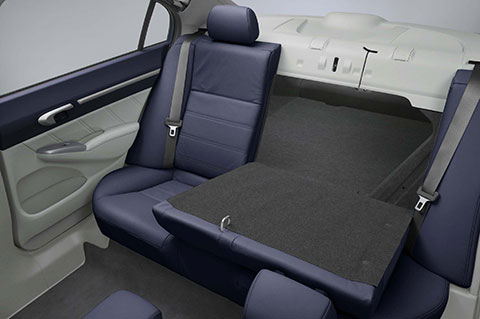
One feature that was removed from the Singapore units and which raised a number of complaints from Singapore TOVA enthusiasts is the folding rear seats. For the case of the Malaysian units, I am happy to say that the new Civic offers split 1/4-3/4 foldable rear seats. The folding back-rests are actually quite unique in design, the folding portion being a rectangular section in the middle and the two side bolsters are fixed. This is because folding the whole back rest will only reveal the chassis tower needed to accomodate the rear multi-link double-wishbone suspension so there's really no point in folding the extreme left and ride portions of the rear seats. The photo on the left shows the 3/4 part of the rear seat backrest folded down and illustrates what I am trying to explain.
More to Come

|
Hence, our sales target for this year (2006) is 30,000 units and we are targeting
the new Civic to make up 20% of the sales. We are also aiming to be No.1 in this
segment.
Yasuhide Mizuno, MD & CEO, Honda Malaysia
|
In his speech at the launch, Mizuno-san openly declared 'war' on Toyota by proclaiming that Honda Malaysia aims to be No. 1 in this segment. 'This segment' of course refers to the compact car segment for Malaysia which have hereto been dominated with an iron grip by the Toyota Altis for the past 5 years or so. Consequently, the Civic has been packaged to compete successfully against the Altis, with the Civic 2.0S especially being designed to totally decimate the Altis. This can be seen by the vastly superior engine and gearbox option of both Civic 1.8S and 2.0S as well as their features. With the Civic 2.0S especially, the approach is a case of whatever you can do, I can do better ! PLUS whatever I can do, you may not be able to ! I think few will argue the validity of these statements as far as packaging and design is concerned. The only real test remains the actual test-drive, to see if some of the limitations of the 7th Gen Civic, especially the soft suspension of the 2.0 i-VTEC, has been finally corrected.
Due to the Formula-1 weekend and its P.R. activities, the test-drive event for this new Civic is only scheduled to be at the end of this month. So while I have finally checked out the Civic in real-life, I have yet to actually drive it ! I am really looking forward to this event next week where I will be able to test drive both the 1.8S and 2.0S. Look forward to the first impressions test-drive report early after that.
Wong KN
March 2006
© Temple of VTEC Asia